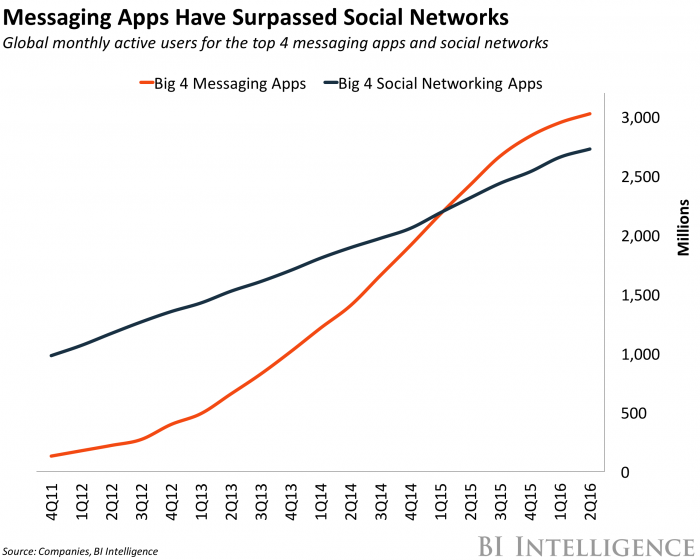Viber transitions to platform and adds e-commerce feature

BI Intelligence
This story was delivered to BI Intelligence Apps and Platforms Briefing subscribers. To learn more and subscribe, please click here.
Viber will begin presenting users with items for sale based on their conversations within the chat app, the company announced Thursday.
Users will be able to access the new feature from March 6. And while in-app payment features are planned, for the moment, users will be redirected to the brand’s app or mobile website to purchase items. The move is indicative of the ongoing trend of messaging apps becoming platforms.
Adding more utility could help Viber become more competitive against Facebook-owned behemoths WhatsApp and Messenger. WhatsApp is the most popular messaging app in 96 countries around the world, and Messenger is the favorite in 53, according to SimilarWeb. Viber, on the other hand, claims just eight countries.
Given that chat apps are an increasingly important point of engagement for brands and businesses, Viber’s move makes sense. Earlier this month, Viber CEO Djamel Agaoua detailed plans on making Viber a one-stop-shop for all users’ internet needs, ranging from e-commerce, to banking, to restaurant booking. Agaoua says that messaging apps’ engagement rates position them to become the new mobile OS.
Messaging apps have a larger audience than social media. There are more than 3 billion monthly active users on the top four messaging apps. That’s more than the top four social media apps.
They’re launched four times more regularly than other apps. On average, chat apps are launched nine times each day, compared with traditional apps’ two times, according to Flurry.
They’re central to smartphone communication. For example, over 60 billion messages are processed by Facebook-owned WhatsApp and Messenger globally every day, according to CEO Mark Zuckerberg. That’s three times more than SMS.
However, chat apps face an uphill battle as telecom regulations, particularly in Europe, could be expanded to include them. This could limit the amount of data these services collect on users, as well as require chat apps to include more rigorous and transparent policies concerning their collection, and use, of user data.
The top four messaging apps — Facebook's Messenger, WhatsApp, WeChat, and Viber — now claim nearly 3 billion monthly active users combined, narrowly outnumbering the combined active users on the world's four largest social networks, including Facebook.
These numbers have caught the attention of a wide range of businesses, publishers among them. News industry leaders including the Wall Street Journal, The Economist, and the BBC are establishing a presence on a number of chat apps in an effort to be out front and build an audience on the latest platforms where people are consuming content. These early adopters are experimenting to learn which chat apps work for their audience and how they can leverage chat for the distribution of digital content, including articles, images, surveys, and video.
BI Intelligence, Business Insider's premium research service, has compiled a detailed report on messaging apps for publishers that looks at the appeal of these apps and how they're becoming a dominant platform for media consumption. It compares the leading chat platforms, including WhatsApp, WeChat, Facebook's Messenger, and Viber, and what features publishers should know about when thinking about how they might leverage these properties. It also looks at strategies for content distribution across chat apps and finally spotlights some of the challenges that publishers may encounter as they begin to dip their toes into content distribution via messaging apps.
Here are some of the key takeaways:
There are dozens of messaging platforms, each with distinct user demographics and features, and these differences will determine which apps a publisher should try and what type of content is most fitting.
Publishers like The Wall Street Journal, The Economist, and the BBC are experimenting to learn which chat apps work for their audience and how they can leverage chat for the distribution of digital content, including articles, images, surveys, and video.
Chat apps are especially appealing to publishers because they allow these brands to tap into users' "dark social" activity. Dark social traffic stems from people sharing content privately through IM programs, messaging apps, and email, among other means.
Because chat apps were once primarily used for peer-to-peer communications, publishers have an opportunity to reach audiences on these platforms through a more conversational exchange.
In full, the report:
Breaks down the pros and cons of each major messaging app.
Explains the different ways publishers can distribute content on messaging apps.
Highlights the differences between native and linked content.
Looks at the potential barriers that could limit chat apps' utility for publishers.
Interested in getting the full report? Here are two ways to access it:
Subscribe to an All-Access pass to BI Intelligence and gain immediate access to this report and over 100 other expertly researched reports. As an added bonus, you'll also gain access to all future reports and daily newsletters to ensure you stay ahead of the curve and benefit personally and professionally. >> START A MEMBERSHIP
Purchase & download the full report from our research store. >> BUY THE REPORT
See Also:

 Yahoo News
Yahoo News 

